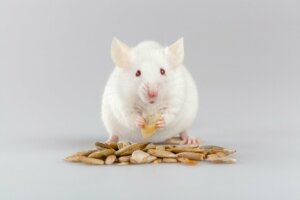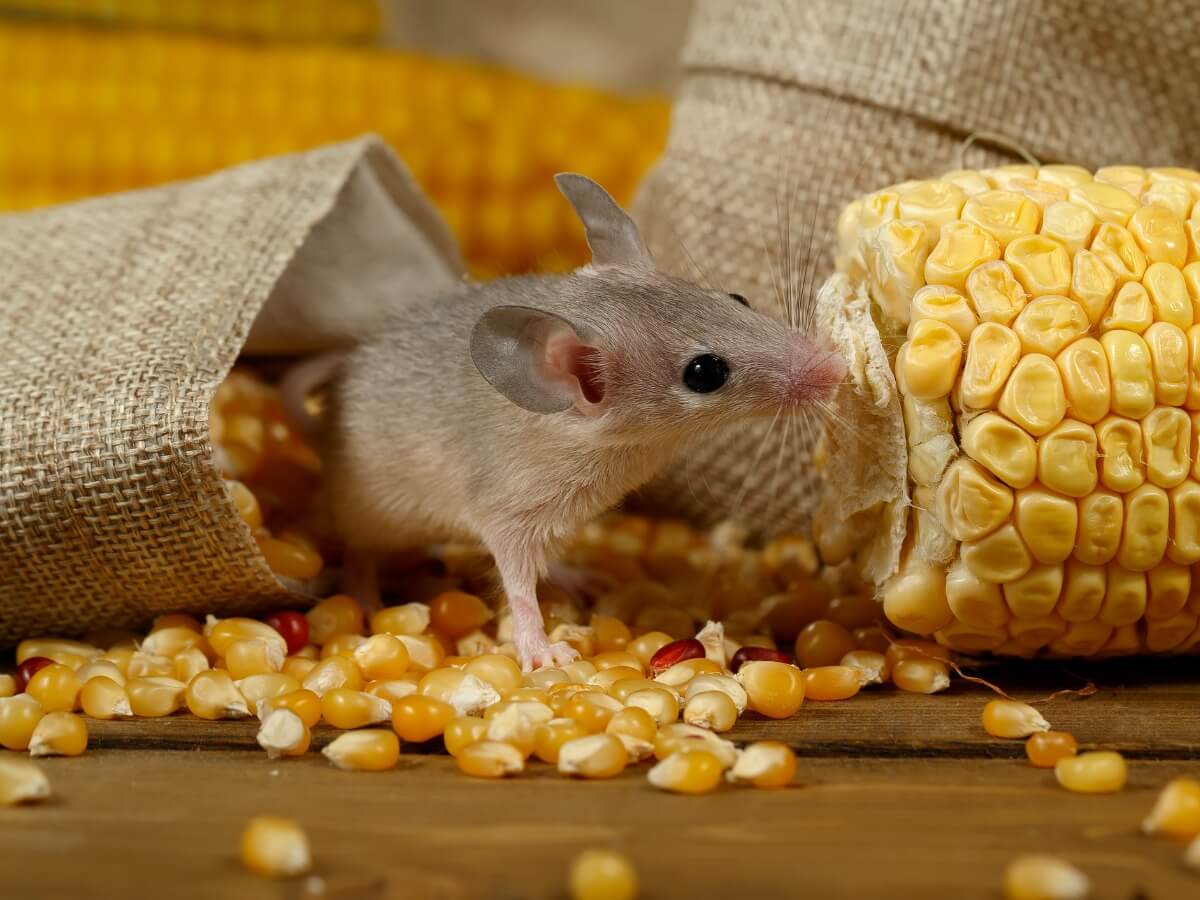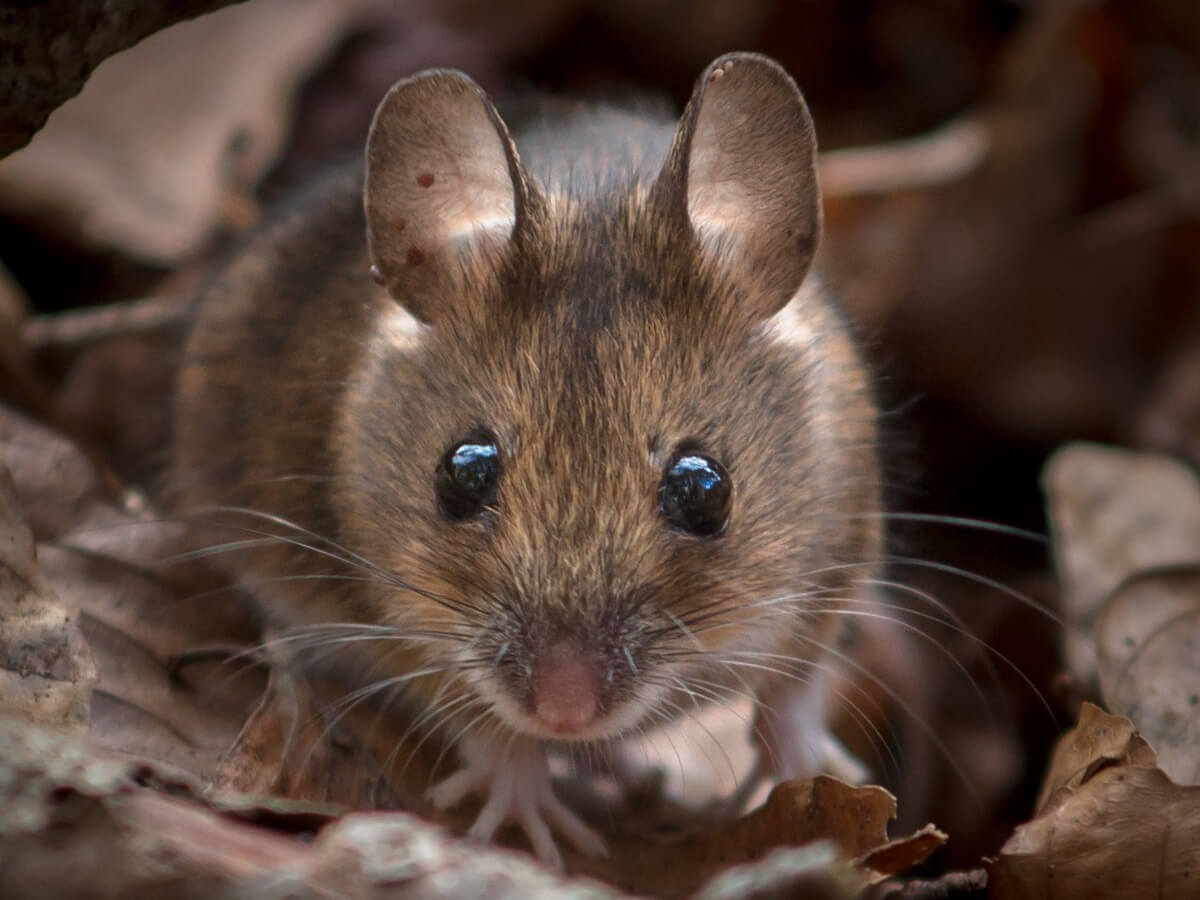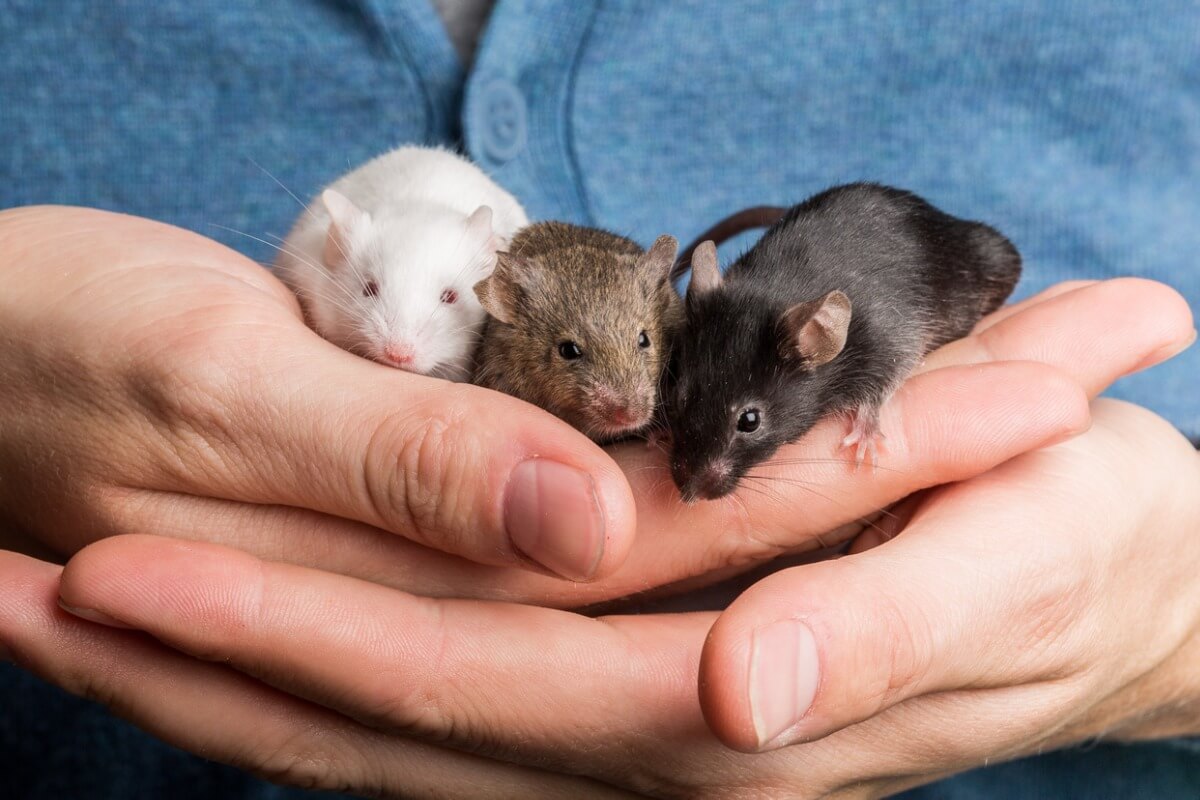What Do Mice Eat?


Written and verified by the biologist Samuel Sanchez
The image of a mouse eating a cheese ball is iconic and has spread throughout the media. However, there is little truth to this belief, as mice aren’t particularly fond of cheese and prefer other foods, such as those rich in sugar. With this in mind, we’ll be asking: do you know what mice eat?
A mouse’s diet varies drastically depending on where they are. In the wild they have a wide range of foods at their disposal, but in homes a specific diet has been devised for them to maximize their survival without excessive costs. Join us and discover what mice eat!
What are mice?
The term mouse defines a small rodent, with a pointed snout, long tail and a fast reproductive rate. It isn’t a term that is of much use at a scientific level, as it encompasses several rodents (order Rodentia) that aren’t close relatives.
The genus of mice par excellence is Mus (family Muridae), which has 38 different species. Among them we have the very famous house mouse (Mus musculus), native to the Mediterranean area and which has colonized practically the whole world. This small rodent enjoys a dubious reputation, as it establishes its population nuclei in human environments (farms, barns and basements).
Beyond this taxon, it should be noted that many other groups contain species of mice. The family Cricetidae also includes several rodents which are similar in appearance to the house mouse, such as Podomys floridanus, Ochrotomys nuttalli and Peromyscus boylii. In addition to this, representatives of the genus Apodemus are known as field mice.

What do wild mice eat?
A mouse’s food choices depend on age, species and the environment they inhabit. Here we’ll tell you about the diet of some of the standard-bearers of this group of rodents.
1. The diet of the common mouse (Mus musculus)
As we have said in previous lines, the common mouse lives near the nuclei of human activity in almost every region of the world. However, in the natural environment, its diet is mostly herbivorous. It feeds on seeds, fleshy roots, green stems and many different types of leaves. In addition, it eats its own feces to obtain even more nutrients.
Despite its predilection for plant matter, these mice are considered omnivores. In the human environment, they’ll eat anything palatable they can get their mouths on, including glue and soap. Neither do they turn their snouts up at dead meat, carbohydrate-rich products, sugary sweets, cockroaches, and other insects both dead and alive.

2. The diet of the wood mouse (Apodemus sylvaticus)
The wood mouse is evenly distributed throughout Europe and also northwestern Africa. As its name suggests, this species has a predilection for forests and meadows, although it also ventures into crop fields in the warmer months of the year. It’s an eminently granivorous rodent, as the basis of its diet are the seeds of trees such as oak, beech, ash, lime, hawthorn and sycamore.
In addition to this, they don’t pass up the opportunity when they encounter insects and other invertebrates (such as slugs). Insectivorous feeding is especially important during spring and early summer, when seeds are scarce. They also sporadically include berries and mushrooms in their diet.

3. The diet of the scorpion mouse (Onychomys torridus)
When asking what mice eat, Onychomys torridus defies all preconceptions. Although their diet consists of 10-25% vegetables and seeds, this rodent is a fierce predator, hunting scorpions, grasshoppers, beetles, lizards and even other mice. Adults often resort to cannibalism and kill members of their own species when food is scarce. It’s also known as the southern grasshopper mouse.
This ferocious rodent is capable of killing its prey with an accurate bite to the head. It’s also resistant to scorpion venom and a scorpion sting won’t kill it. Not only that, but it uses the defensive toxins of these arachnids as an analgesic to alleviate the pain produced by other injuries during attacks. Without a doubt, it’s a natural-born killer.
What do mice eat in captivity?
Most house mice belong to the species Mus musculus, but they’ve been selected over the years to have somewhat different colours, sizes and morphological features to their wild relative.
The diet of these rodents in captivity is based on the following:
- Mouse-specific seed mix: This should make up the bulk of the rodent’s diet. House mice love muesli-type food and gnawing on the surface of different grains and seeds (always without salt or seasoning), so special feeds for them are ideal as a nutritional basis.
- Fruits: Apples (seedless), pears, peaches, dried bananas and red fruits.
- Vegetables: Broccoli, carrots, cauliflower, cucumber, sweet pepper and peas, among others.
- Meat products: These can be offered very sporadically, but aren’t necessary. Boiled turkey or chicken are good choices.
In addition to varying the mouse’s diet, it’s recommended to hide some of its food in nooks and crannies and high areas of the cage in order to exercise its natural foraging behavior. Don’t forget that it’s an animal with a strong instinctive component and requires constant environmental enrichment.

As you can see, the answer to the question of what mice eat depends on the species we look at, as well as their habitat. Most of these rodents are granivorous and peaceful, although a few stand out for their incredible predatory capacity. Be that as it may, they’re still fascinating animals and well worth knowing about.
The image of a mouse eating a cheese ball is iconic and has spread throughout the media. However, there is little truth to this belief, as mice aren’t particularly fond of cheese and prefer other foods, such as those rich in sugar. With this in mind, we’ll be asking: do you know what mice eat?
A mouse’s diet varies drastically depending on where they are. In the wild they have a wide range of foods at their disposal, but in homes a specific diet has been devised for them to maximize their survival without excessive costs. Join us and discover what mice eat!
What are mice?
The term mouse defines a small rodent, with a pointed snout, long tail and a fast reproductive rate. It isn’t a term that is of much use at a scientific level, as it encompasses several rodents (order Rodentia) that aren’t close relatives.
The genus of mice par excellence is Mus (family Muridae), which has 38 different species. Among them we have the very famous house mouse (Mus musculus), native to the Mediterranean area and which has colonized practically the whole world. This small rodent enjoys a dubious reputation, as it establishes its population nuclei in human environments (farms, barns and basements).
Beyond this taxon, it should be noted that many other groups contain species of mice. The family Cricetidae also includes several rodents which are similar in appearance to the house mouse, such as Podomys floridanus, Ochrotomys nuttalli and Peromyscus boylii. In addition to this, representatives of the genus Apodemus are known as field mice.

What do wild mice eat?
A mouse’s food choices depend on age, species and the environment they inhabit. Here we’ll tell you about the diet of some of the standard-bearers of this group of rodents.
1. The diet of the common mouse (Mus musculus)
As we have said in previous lines, the common mouse lives near the nuclei of human activity in almost every region of the world. However, in the natural environment, its diet is mostly herbivorous. It feeds on seeds, fleshy roots, green stems and many different types of leaves. In addition, it eats its own feces to obtain even more nutrients.
Despite its predilection for plant matter, these mice are considered omnivores. In the human environment, they’ll eat anything palatable they can get their mouths on, including glue and soap. Neither do they turn their snouts up at dead meat, carbohydrate-rich products, sugary sweets, cockroaches, and other insects both dead and alive.

2. The diet of the wood mouse (Apodemus sylvaticus)
The wood mouse is evenly distributed throughout Europe and also northwestern Africa. As its name suggests, this species has a predilection for forests and meadows, although it also ventures into crop fields in the warmer months of the year. It’s an eminently granivorous rodent, as the basis of its diet are the seeds of trees such as oak, beech, ash, lime, hawthorn and sycamore.
In addition to this, they don’t pass up the opportunity when they encounter insects and other invertebrates (such as slugs). Insectivorous feeding is especially important during spring and early summer, when seeds are scarce. They also sporadically include berries and mushrooms in their diet.

3. The diet of the scorpion mouse (Onychomys torridus)
When asking what mice eat, Onychomys torridus defies all preconceptions. Although their diet consists of 10-25% vegetables and seeds, this rodent is a fierce predator, hunting scorpions, grasshoppers, beetles, lizards and even other mice. Adults often resort to cannibalism and kill members of their own species when food is scarce. It’s also known as the southern grasshopper mouse.
This ferocious rodent is capable of killing its prey with an accurate bite to the head. It’s also resistant to scorpion venom and a scorpion sting won’t kill it. Not only that, but it uses the defensive toxins of these arachnids as an analgesic to alleviate the pain produced by other injuries during attacks. Without a doubt, it’s a natural-born killer.
What do mice eat in captivity?
Most house mice belong to the species Mus musculus, but they’ve been selected over the years to have somewhat different colours, sizes and morphological features to their wild relative.
The diet of these rodents in captivity is based on the following:
- Mouse-specific seed mix: This should make up the bulk of the rodent’s diet. House mice love muesli-type food and gnawing on the surface of different grains and seeds (always without salt or seasoning), so special feeds for them are ideal as a nutritional basis.
- Fruits: Apples (seedless), pears, peaches, dried bananas and red fruits.
- Vegetables: Broccoli, carrots, cauliflower, cucumber, sweet pepper and peas, among others.
- Meat products: These can be offered very sporadically, but aren’t necessary. Boiled turkey or chicken are good choices.
In addition to varying the mouse’s diet, it’s recommended to hide some of its food in nooks and crannies and high areas of the cage in order to exercise its natural foraging behavior. Don’t forget that it’s an animal with a strong instinctive component and requires constant environmental enrichment.

As you can see, the answer to the question of what mice eat depends on the species we look at, as well as their habitat. Most of these rodents are granivorous and peaceful, although a few stand out for their incredible predatory capacity. Be that as it may, they’re still fascinating animals and well worth knowing about.
All cited sources were thoroughly reviewed by our team to ensure their quality, reliability, currency, and validity. The bibliography of this article was considered reliable and of academic or scientific accuracy.
- Mouse, enciclopedia Britannica. Recogido a 9 de noviembre en https://www.britannica.com/animal/mouse-rodent#:~:text=mouse%2C%20(genus%20Mus)%2C,the%20Latin%20word%20for%20mouse.
- Mus musculus, ADW. Recogido a 9 de noviembre en https://animaldiversity.org/accounts/Mus_musculus/
- Apodemus sylvaticus, ADW. Recogido a 9 de noviembre en https://animaldiversity.org/accounts/Apodemus_sylvaticus/
- Onychomys torridus, ADW. Recogido a 9 de noviembre en https://animaldiversity.org/accounts/Onychomys_torridus/
This text is provided for informational purposes only and does not replace consultation with a professional. If in doubt, consult your specialist.








